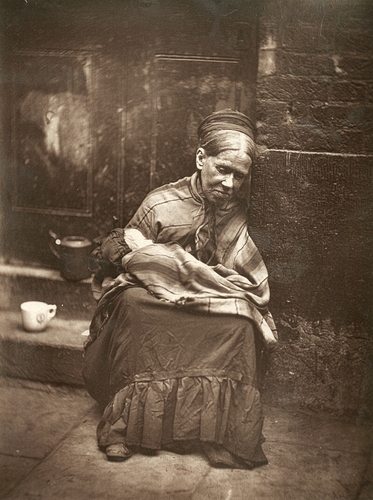Photographing the 19th century ‘Street Life’ of London: John Thomson’s social documentary images
posted Friday, August 9, 2013 at 4:42 PM EDT

You may have never heard of John Thomson, a pioneering Scottish photographer and geographer who traveled extensively throughout Asia in the latter part of the 19th century taking pictures. He worked extensively in Cambodia, Thailand, Taiwan and China and later Cyprus, photographing the landscapes, people and artifacts of these nations. His most famous work, the collected images that appear in the book "Street Life in London," is an example of early social documentary photography -- the kind of work upon which photojournalism was later built.
Thomson's street photography predates the work of Parisian photographer Eugène Atget by several decades. And like Atget, Thomson worked with a large format, glass-plate wooden camera mounted on a heavy wooden tripod. This equipment, naturally, didn't allow him to capture Henri Cartier-Bresson's "decisive moments" or to "shoot from the hip" like Garry Winogrand. Instead, the bulky camera dictated a slower, more methodical approach: Thomson had to stop people on the street and ask them to pose for him. When they agreed, and some were probably paid to do so, he would set-up the image he wanted and make the shot.

The Crawlers
Photograph by John Thomson
Documenting social strife
Despite this limitation, Thomson managed to produce some remarkable images. I particularly like his portraits, the photographs of "Tickets" the card dealer, "Caney" the clown or the London boardman. In these images and others he took of London's poor neighborhoods, Thomson documents a remarkable moment in time.

Tickets, the Card Dealer
Photograph by John Thomson
In the late 19th century, London was the capital city of a vast Empire, experiencing both incredible wealth and painful poverty. The wealth came from India and the Far East, from the very places Thomson had gone to photograph. England's trade made the rich very rich, but it left millions behind. The industrial revolution brought with it massive unemployment and class conflict. Literature of the time reflects this social inequality, and the class divide is evident in books such as Charles Dickens's "A Tale of Two Cities" or Robert Louis Stevenson's "Dr. Jekyll and Mr. Hyde." Believe it or not, Bram Stoker's "Dracula" takes it a step further as the rich -- personified by the Count -- actually feed off the blood of the poor.

Caney, the Clown
Photograph by John Thomson
Thomson realized that his photographs alone were not enough to convey the full impact of the poverty he encountered, so he recruited a "radical" journalist, Adolphe Smith, to interview the street people that he photographed. Together they authored "Street Life in London."

The London Boardman
Photograph by John Thomson
Thomson's travels
Born in Scotland 1837, Thomson left Edinburgh in 1862 to go to Singapore where his brother lived. He set up a successful portrait studio which was frequented by European merchants. He also developed a deep interest in the local Asian cultures. From this base, for nearly 10 years, he traveled throughout Malaysia, Sumatra, Ceylon (Sri Lanka), India and Siam (Thailand), making photographs and eventually in Siam even managed to photograph the King and members of his royal court.

King Mongkut of Siam
Photograph by John Thomson
His images of Angkor Wat in Cambodia were among the earliest ever taken of the site. Thomson published several books of his photographs, including "The Antiquities of Cambodia" (1867), "Illustrations of China and its People" (1873-1874), "Through Cyprus with the Camera" (1879), and "Through China with a Camera" (1898).

Island Pagoda
Photograph by John Thomson
The photographs Thomson made on these travels were glass plate negatives which were printed for publication by the Woodburytype process. Developed by Walter B. Woodbury in 1864, and first used in 1866, it became the standard for high-quality photo reproduction from about 1870 to 1900. It was the only commercially successful method of printing photographs that retained all of the tonality and details of the original photographic image. (You can learn more about the Woodburytype process and other print-making techniques here.)
Returning to publish
Thomson settled in Brixton, London, in 1872, and most of his photographs were initially published in serial form in monthly magazines, much like Conan Doyle's Sherlock Holmes stories before being published as books. Thomson began to write extensively on photography and from 1876-1877 took the photographs that eventually were published as "Street Life in London."

Recruiting Sergeants at Westminster
Photograph by John Thomson
This book made his reputation. and in 1879 he opened a portrait studio that was very successful. In 1881, Queen Victoria made him photographer to the royal family and in 1886 he began teaching the techniques of documentary photography to "explorers" at the Royal Geographic Society.
In 1910 he returned to Edinburgh but continued to teach at the Royal Geographic. He died of a heart attack in 1921 at the age of 84.

The Independent Shoe Black
Photograph by John Thomson

Street Doctor
Photograph by John Thomson

Convent Gardens Flower Women
Photograph by John Thomson